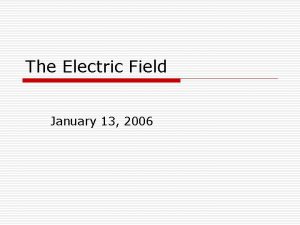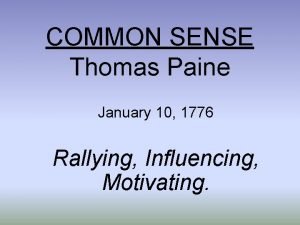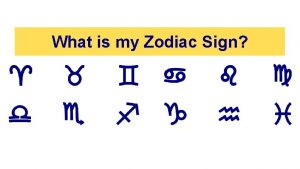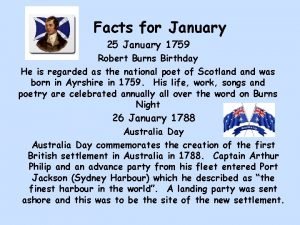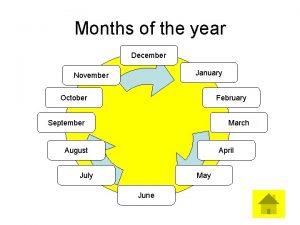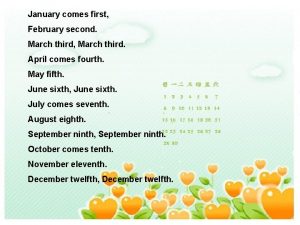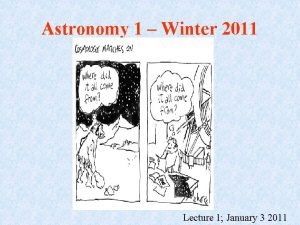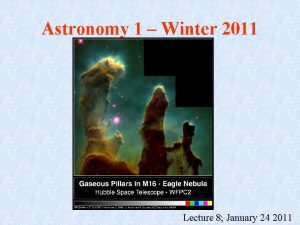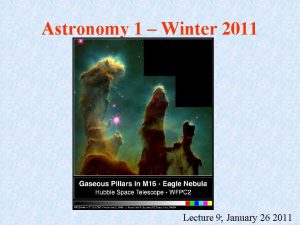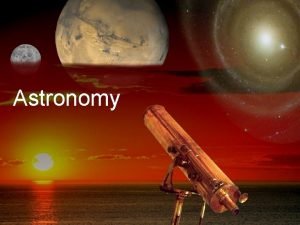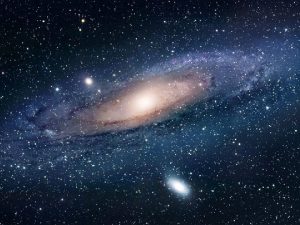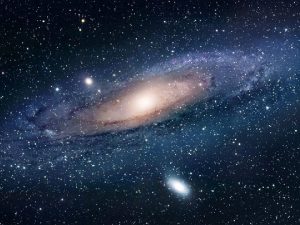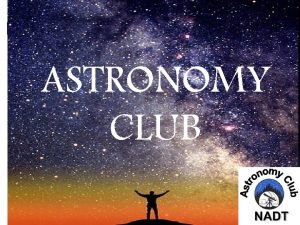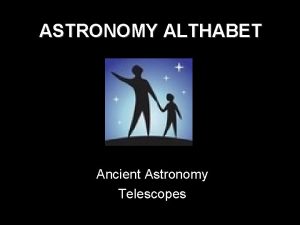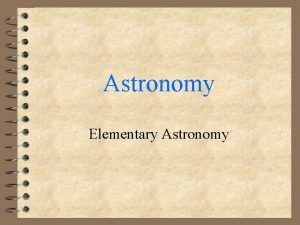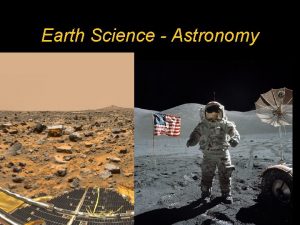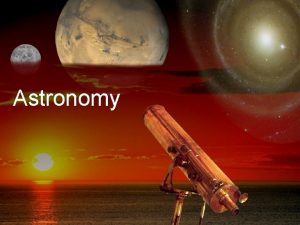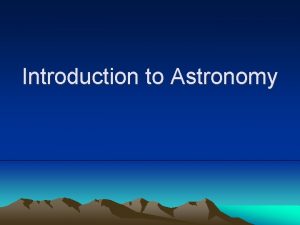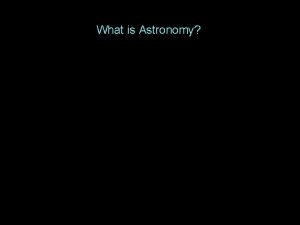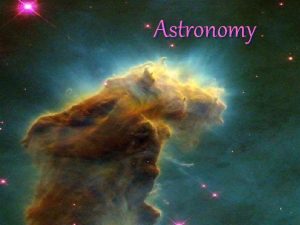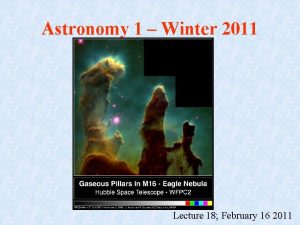Astronomy 1 Winter 2011 Lecture 11 January 31





































- Slides: 37

Astronomy 1 – Winter 2011 Lecture 11; January 31 2011

Previously on Astro-1 • Properties of the Planets: – Orbits in the same plane and direction – Inner planets are small and made of heavy elements – Outer planets are big and made of light elements • Other bodies in the Solar system – There are seven large satellites (like the moon) – Outer solar system is populated by TNO, KBO and comets • How do we learn about solar system bodies? – We send probes – Spectroscopy reveals the composition of atmospheres – Craters and magnetic fields reveal the presence of a liquid melted core

Today on Astro-1 • The origin of the solar system • How old? • How did it form? – Clues from our solar system – Clues from other worlds

A note on homework • For 7. 28 you need to know the speed of hydrogen atoms on the sun’s surface. It is 1. 2 km/s and it is derived in 7. 27. If you are interested do 7. 27 as well.

A meteorite: the surface shows evidence of having been melted by air friction as it entered our atmosphere at 40, 000 km/h (25, 000 mi/h). Meteorites are the oldest objects in the solar system.

• Each type of radioactive nucleus decays at its own characteristic rate, called its half-life, which can be measured in the laboratory • This is used in radioactive age-dating to determine the ages of rocks • Age of oldest rocks in the solar system: 4. 56 x 109 years

Jovian planets Terrestrial planets Small, high density, rocky Large, low density, gaseous



Dust that used to be in Antares The dying star Antares is shedding material from its outer layers, forming a thin cloud around the star.

The abundances of the 30 lightest elements Made in stars All elements heavier than zinc (Zn) have abundances of fewer than 1000 atoms per 1012 atoms of hydrogen.


Question 11. 1 (iclickers!) • How has the present mix of chemical elements in the Universe been produced? • A) All the known elements have been formed by the radioactive breakup of the heavy elements formed in the initial Big Bang • B) All of the known elements were formed in the Big Bang • C)H and He were formed in the Big Bang, while the heavier elements have been slowly forming by collisions in cold interstellar gas clouds • D) H and some He were formed in the Big Bang, while the heavier elements have been slowly formed in the centers of stars over the life of the Universe.

The formation of the sun and its planets




Probable temperatures variations across the solar nebula as the solar system was forming.

The young Sun was hotter than it is today. In the inner part of the solar system, only the heavier elements could remain solid – lighter stuff could not condense, and got blown farther out, until it found a spot cool enough to condense. Since there are fewer heavy elements, the terrestrial planets formed close-in are smaller than the gas giants.



Core accretion Theory vs Disk instability theory for Jovian planets

Planetesimal accretion is still happening! The rate has slowed. In 1994 comet Shoemaker-Levy 9 hit Jupiter. BBC Video

Jovian Planets and their satellites

The Kuiper Belt: The gravitational influence of the Jovian planets pushed small, icy objects to the outer reaches of the solar system past Neptune. The result shown in this artist’s conception is the Kuiper belt, a ring populated by trans-Neptunian objects like Pluto, icy planetesimals, and dust.

If you slice open a meteorite you see chondrules – regions that melted due to rapid heating and cooling in the early solar system.

Stardust – mission to collect dust from interplanetary space and Comet Wild 2. This highly magnified image shows a microscopic dust grain that came from interplanetary space. It entered Earth’s upper atmosphere and was collected by a high-flying aircraft. Dust grains of this sort are abundant in star-forming regions like the Orion nebula. These tiny grains were also abundant in the solar nebula and served as the building blocks of the planets.

Question 11. 2 (iclickers!) • The formation of terrestrial planets around a star is thought to have occurred by what process? • A) Breakup of a large disk of matter which formed around the star • B) Condensation of gas from the original star nebula • C) Capture by the star of objects traversing the depths of space • D) Accretion or slow accumulation of smaller particles by mutual gravitational attraction

Question 11. 3 (iclickers!) • In order for the disk instability model to be able to account for the formation of the Jovian planets • A) The rocky material would have to be confined completely to the inner parts of the solar system • B) The gas in the nebular disk would have to be at the very high temperature • C) The gas in the nebular disk would have to be clumpy rather than smooth • D) The gas in the nebular disk would have to be mostly methane and ammonia rather than hydrogen and helium

Evidence from other worlds


Infrared image showing IRAS 043022247, a young star that is still surrounded by a disk of gas and dust – it is much larger than our solar system and will shrink.


ph agra on Cor Formal haut’s “Kuipe r belt”


Summary • Solar System Formation: the nebular hypothesis. • The Sun: – formed by gravitational contraction of the center of the nebula. • Terrestrial planets: – formed through accretion of dust particles into planetesimals, then into larger protoplanets. • Jovian planets: – Began as rocky protoplanetary cores, similar in character to the terrestrial planets. Gas then accreted onto these cores. – Alternatively, they formed directly from the gases of the solar nebula. In this model the cores formed from planetesimals falling into the planets.

The End See you on wednesday
 Learning astronomy by doing astronomy
Learning astronomy by doing astronomy Learning astronomy by doing astronomy activity 1 answers
Learning astronomy by doing astronomy activity 1 answers Learning astronomy by doing astronomy
Learning astronomy by doing astronomy Winter kommt winter kommt flocken fallen nieder
Winter kommt winter kommt flocken fallen nieder Winter kommt flocken fallen nieder
Winter kommt flocken fallen nieder Es war eine mutter
Es war eine mutter 01:640:244 lecture notes - lecture 15: plat, idah, farad
01:640:244 lecture notes - lecture 15: plat, idah, farad Analyze the responses of franklin dbq
Analyze the responses of franklin dbq February and march season
February and march season Tinseltow
Tinseltow What is the theme for the month of january
What is the theme for the month of january January starts the year poem risa jordan
January starts the year poem risa jordan January 15, 1929
January 15, 1929 January february march april may june july august
January february march april may june july august Mozart was born in this country
Mozart was born in this country Nysedregents
Nysedregents January 19 1809
January 19 1809 He was born in salzburg austria on january 27 1756
He was born in salzburg austria on january 27 1756 1995 january 23 nasa
1995 january 23 nasa January 27 1756
January 27 1756 January 15 1929
January 15 1929 You must wash that shirt for tonight’s party
You must wash that shirt for tonight’s party January february maruary
January february maruary Blackberry devices working on january
Blackberry devices working on january Star life cycle from birth to death
Star life cycle from birth to death Ib history ia grade boundaries
Ib history ia grade boundaries 25 january scotland
25 january scotland Pro-forma entry
Pro-forma entry January 13 2006 calendar
January 13 2006 calendar January 10th 1776
January 10th 1776 Zodiac for january 20
Zodiac for january 20 1st january 2018
1st january 2018 His birth date was on 25 january 1759
His birth date was on 25 january 1759 January 27 1756
January 27 1756 January 29 2015
January 29 2015 December november october
December november october Chemistry regents january 2018 answers
Chemistry regents january 2018 answers January comes before february
January comes before february




























